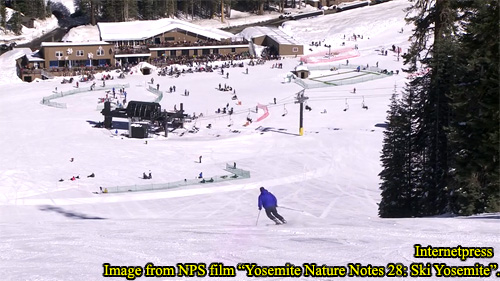
Downhill Skiing Experience at Badger Pass
Discover the historic Badger Pass Ski Area in Yosemite National Park through this concise guide to downhill skiing. This article introduces beginners, intermediate, and advanced ski slopes, complete with helpful maps and elevation profiles. Whether you're taking your first lesson or looking for a thrilling new run, you'll find everything you need to plan an unforgettable winter adventure in one of America's most iconic national parks.
Publish Date: March 3, 2025
Revision Date: March 3, 2025
Yosemite National Park Visitor's Guide is a Trademark.
Copyright © 2025 by Internetpress®
Introduction
When you set out to ski the runs at Badger Pass, you’ll find the resort’s overall character is family-friendly, comfortable, and ideal for building confidence on the snow. Although there are runs suited for advanced skiers, much of the terrain caters to beginners and intermediates, ensuring that newcomers won’t feel intimidated by overly challenging descents. A key element of the Badger Pass skiing experience is understanding slope ratio, which is determined by measuring how steep each run is—its “rise-to-run” ratio. For example, a 1:10 ratio indicates a gentle run, dropping one foot vertically for every 10 feet traveled horizontally.
At Badger Pass, the gentler beginner runs feature slope ratios ranging roughly from 1:20 to 1:5, giving novices the perfect place to master turning and stopping. Intermediate runs typically span slope ratios from 1:10 to 1:3, offering a bit more of a challenge for those looking to improve. If you’re an advanced skier wanting a faster pace, you’ll also find terrain with slope ratios as steep as 1:2.3. Whatever your skill level, there’s plenty of room to grow and enjoy your time here.
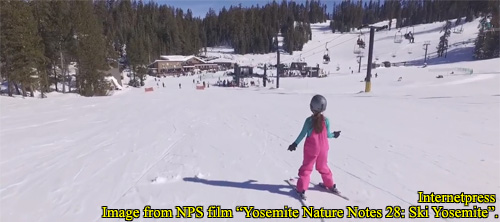
Gentle Slopes for Beginners and Children
Badger Pass devotes special care to its newest and youngest skiers, offering runs with slope ratios ranging from about 1:20 to 1:5—comfortably mild inclines for easing into basic skiing techniques. One standout area for beginners is the Turtle run, which measures 500 feet (152 m) in length with a drop of 43 feet (14 m). Its very gentle slope ratio—from about 1:20 to 1:11—helps novices find their footing and gain confidence without feeling rushed or overwhelmed. A simple cable tow lift takes you easily back to the top, allowing for multiple practice runs in quick succession.
If you’re traveling with family, this nurturing setup provides a comforting space for children to learn the fundamentals. Couples and singles who are new to the sport will also find plenty of opportunities to get comfortable here, surrounded by Badger Pass’s welcoming atmosphere.
Once you’re feeling steady on these gentle runs, it might be time to progress to slightly steeper terrain. Discover how the Intermediate Runs for Building Confidence can help you hone your skills and explore more of the mountain.
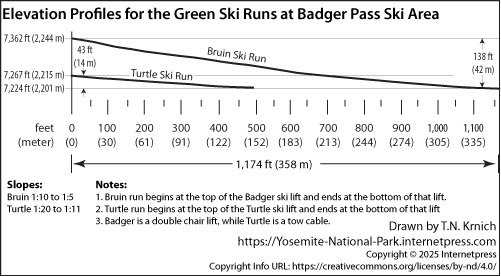
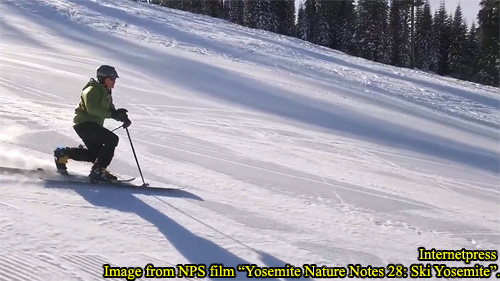
Intermediate Runs for Building Confidence
After finding your balance on beginner runs, the intermediate runs at Badger Pass provide the next step in developing technique. Featuring slope ratios roughly between 1:10 and 1:2, these blue-rated runs encourage skiers to push their limits while refining control and speed.
A popular choice for building confidence is the Beaver run, which stretches about 1,700 feet (518 m) with a 298-foot (90 m) vertical drop—translating to a slope ratio of about 1:10 to 1:3.3. To reach Beaver, you’ll ski the upper portion of the Eagle run first, adding an extra 2,000 feet (610 m) for a total of 4,557 feet (1,389 m). Eagle is served by two chairlifts for convenient access. For additional variety, you can veer onto Chipmunk or Rabbit off Eagle, extending your run by about 400 feet and offering some scenic woodland views. Whether you’re visiting with family, enjoying time as a couple, or skiing solo, these intermediate runs give you a chance to progress at a comfortable pace.

Looking for a faster, steeper challenge? Read on for the "Advanced Runs for More Experienced Skiers," where Badger Pass shows its livelier side.

Advanced Slopes for More Experienced Skiers
Although Badger Pass is well-known for its friendly, approachable environment, advanced skiers can still find invigorating descents. Two primary advanced runs—Red Fox and Wildcat—are reached via connecting “turkey trails” from about halfway down the Eagle run, creating an adrenaline-pumping detour.
- Red Fox: Approximately 1,200 feet (366 m) long with a 298-foot (90 m) drop, featuring slope ratios of 1:3 to 1:2.3. This steep gradient requires quick, agile turns and solid edge control.
- Wildcat: Roughly 1,300 feet (396 m) in length (also with a 298-foot/90 m drop) and slope ratios of 1:5 to 1:2.7, delivering a lively ride.
These runs satisfy the appetites of expert skiers eager to test their mettle while taking in Yosemite’s awe-inspiring landscapes.
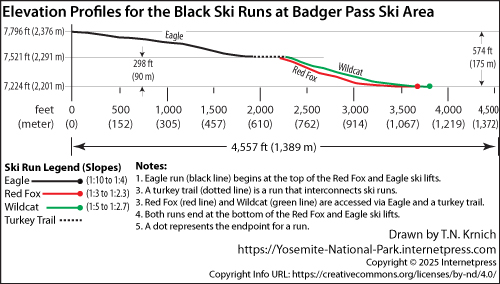
No matter which runs you choose, Badger Pass offers something for everyone. Let’s gather all the possibilities in one final look at A Well-Rounded Experience, showing how families, couples, and singles alike can enjoy this welcoming ski area.
A Well-Rounded Experience
From the gentle Turtle run for first-timers to the inviting challenge of Beaver and Eagle, and finally to the energetic thrills on Red Fox and Wildcat, Badger Pass provides a wide-ranging experience on the mountain. Families can embrace the supportive learning environment, couples can savor scenic descents while sharing moments together, and singles—whether beginners or seasoned experts—find plenty of opportunities to meet fellow enthusiasts or enjoy the freedom of skiing solo.
It’s this welcoming spirit, combined with Yosemite’s breathtaking setting, that makes Badger Pass Ski Area a cherished winter destination. Whether you’re seeking an easy introduction or a spirited run through fresh powder, you’ll depart with unforgettable memories—and perhaps new friendships—that last well beyond the final melt.
Maps of Badger Pass Downhill Ski Runs
Presented here is an edited version of a brochure map that was distributed to Badger Pass visitors between approximately 1992 and 2004. This updated version aims to make the features more accurate and easier to interpret, while still reflecting the distinctive character of the original. The map itself is an elevated view looking south across the ski area, highlighting all ten downhill runs and five ski lifts.
Each of the ski runs is color-coded by difficulty level: Green slopes are the gentlest, ideal for beginners or children; Blue runs offer a moderate challenge for intermediate skiers; and Black trails are advanced courses best suited for experienced skiers who want steeper pitches. All five ski lifts appear in red, with four being conventional chair lifts and a short cable tow serving the Turtle run, specifically designed for new skiers and young children. At the lower right section of the map, the Badger Pass Access Road can be seen winding in from Glacier Point Road (which lies just off the map). Before reaching the parking area, you’ll notice a small building to the right—this is the Park Ranger Station, which also houses the Ski Patrol headquarters, a first aid station, and a lost and found service.
From there, visitors arrive at the main parking lot shown at the bottom center of the map. Three notable buildings cluster around this area: the Cross-Country Ski Center on the left, and the Ski Lodge (or Day Lodge) in the middle, where you’ll find food services, lockers, the Tiny Tots Room, the Ski School, equipment rentals, and a ski shop. Just below the lot, a groomed trailhead connects to the Glacier Point Road cross-country trail system. Beyond the ski area access point, Glacier Point Road is closed to automobile traffic in winter, maintaining peaceful, snow-covered routes for skiers and snowshoers. On the left side of the parking lot, look for a blue path indicating the trailhead to the Old Glacier Point Road cross-country ski trail, which also offers an alternate route to the summit of Badger Pass.
Highlighted in Yellow are “slow circulation areas”—spots where traffic can become congested. Skiers of all levels are reminded to moderate their speed here, remain aware of others, and practice safe etiquette so that everyone can enjoy Badger Pass to its fullest.
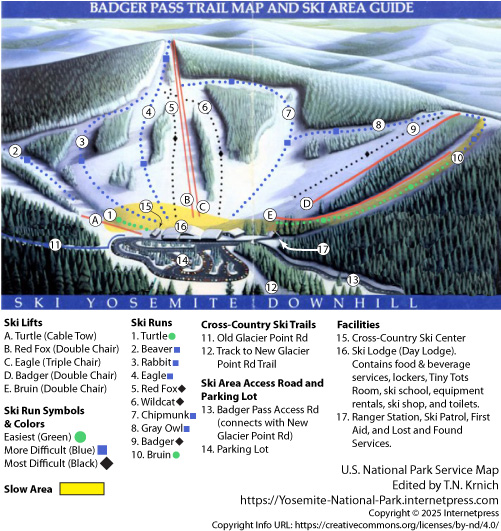
.jpg)

Ski Area Contact Information
Yosemite Hospitality provides the most up-to-date information on operating status and snow conditions through its website, www.TravelYosemite.com, and through the “Snow Phone” at (209) 372-1000, which plays a recorded message about current conditions. For direct inquiries, you can call Aramark Destinations at (888) 413-8869 and ask for information regarding Badger Pass. When open, the ski lodge operates daily from 8:30 AM to 4:00 PM, providing locker rentals, food service, and ticket sales. The Nordic Center's number, where ski rentals and possibly the ski school are located, is (209) 372-4996. The ski lifts generally run from 9:00 AM to 4:00 PM.